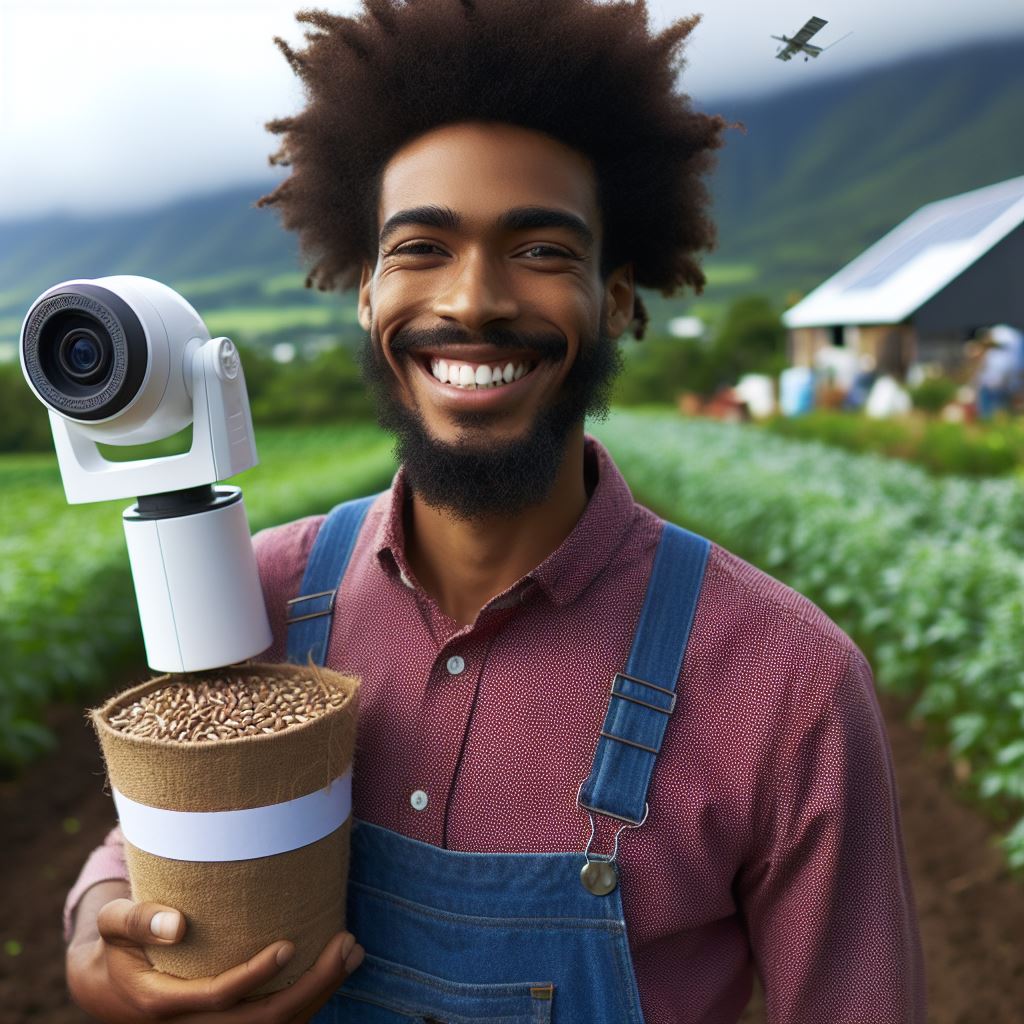Introduction
The farming landscape is evolving, propelled by the dynamic force of farming tech from seeds to satellites.
Innovations, from seeds to satellites, are reshaping agriculture.
Technology streamlines processes, enhances yields, and ensures sustainability.
Advancements like precision farming, drone surveillance, and data analytics optimize resource utilization.
This tech infusion empowers farmers to make data-driven decisions, boosting efficiency and productivity.
Throughout this section, we delve into the pivotal role of technology in modern agriculture.
We explore how it’s revolutionizing traditional farming methods.
From automated machinery to genetic engineering, technology offers solutions to age-old challenges.
We’ll discuss the benefits of these advancements, including increased crop yields and reduced environmental impact.
Moreover, we’ll examine the integration of artificial intelligence and IoT devices on farms.
These technologies enable real-time monitoring and management, fostering precision and accuracy in farming operations.
Additionally, we’ll highlight the importance of data analytics in decision-making processes.
Join us on this journey as we uncover the transformative impact of technology on farming practices.
From seed selection to market distribution, technology is the driving force behind agricultural innovation.
Together, let’s embrace the future of farming, where technology paves the way for a more sustainable and resilient agricultural sector.
The role of technology in seed selection and planting
Introduction to the use of advanced technology in seed selection
- Advanced technology has revolutionized the process of seed selection in modern farming.
- Farmers now have access to sophisticated tools that help them make informed decisions.
- These tools include genetic mapping, remote sensing, and data analysis.
- By utilizing these technologies, farmers can choose seeds that are best suited for their specific conditions.
Benefits and capabilities of modern seed selection tools
- Modern seed selection tools offer numerous benefits to farmers.
- Genetic mapping allows farmers to identify traits that enhance yield, resist diseases, or tolerate environmental stress.
- Remote sensing technologies provide valuable data on soil conditions, moisture levels, and plant health.
- Data analysis tools help farmers analyze large sets of information and make data-driven decisions.
- By using these tools, farmers can maximize crop productivity and minimize potential risks.
Precision planting and its impact on yield and efficiency
- Precision planting is another technological advancement that has transformed farming practices.
- It involves using specialized equipment to precisely place seeds in the soil at optimal depths and spacing.
- This ensures uniform plant growth and reduces competition for resources among plants.
- Precision planting maximizes yield potential and improves overall efficiency.
- Farmers can achieve better crop emergence, uniform maturity, and easier harvesting.
In fact, technology plays a crucial role in seed selection and planting in modern farming.
Advanced tools and techniques enable farmers to choose the most suitable seeds for their specific needs.
Genetic mapping, remote sensing, and data analysis help farmers identify traits, assess soil conditions, and make informed decisions.
Precision planting techniques further enhance crop productivity by ensuring optimal seed placement and uniform plant growth.
By embracing these technological advancements, farmers can significantly improve their yield and operational efficiency.
Read: Pest Plight: Stories from the Field
Technological advancements in crop monitoring and management
Introduction to the use of satellites and drones in crop monitoring
In recent years, the agriculture industry has experienced a significant shift in the way crops are monitored and managed.
Technological advancements, particularly the use of satellites and drones, have revolutionized the way farmers collect crucial data about their crops.
Satellites provide a bird’s-eye view of the fields, allowing farmers to monitor various aspects of crop health and growth.
With the help of remote sensing technology, satellites can capture images and data that enable farmers to detect early signs of stress, identify nutrient deficiencies, and assess the overall health of the plants.
Drones, on the other hand, offer a more localized perspective.
Equipped with high-resolution cameras and sensors, drones can fly over specific areas of the field, capturing images and data at a much closer range.
This allows farmers to identify problem areas, such as pest infestations or irrigation issues, with greater precision.
Overview of the benefits of real-time data collection and analysis
One of the key advantages of using satellites and drones for crop monitoring is the ability to collect real-time data.
Traditional methods of data collection, such as manual field inspections, are time-consuming and often provide delayed information.
With the implementation of technology, farmers can now monitor their crops on a near real-time basis, enabling them to make informed decisions promptly.
Real-time data collection allows farmers to detect and respond to any changes in crop conditions quickly.
By identifying issues early on, farmers can prevent further damage, saving both time and resources.
Additionally, real-time data analysis provides valuable insights into crop performance, enabling farmers to optimize their farming practices and increase overall productivity.
The use of sensors and smart irrigation systems for better crop management
In addition to satellites and drones, sensors and smart irrigation systems are also revolutionizing crop management.
Sensors placed throughout the fields can monitor soil moisture levels, temperature, and other environmental factors.
The data collected by these sensors can be analyzed to determine optimal irrigation schedules and conditions, ensuring that crops receive the right amount of water at the right time.
Smart irrigation systems take this technology a step further by using real-time data to automatically adjust irrigation schedules and water application rates.
This not only improves water efficiency but also minimizes the risk of overwatering or underwatering crops.
By providing plants with the precise amount of water they need, farmers can promote healthy growth and reduce water waste.
Examples of how technology is improving pest and disease monitoring and control
Another critical aspect of crop management is pest and disease monitoring and control.
Advancements in technology have introduced innovative solutions that help farmers detect and combat these threats more effectively.
Satellite imagery can help identify areas of the field with significant pest populations or disease outbreaks, enabling farmers to focus their control measures on specific hotspots.
Drones equipped with infrared cameras can also detect changes in crop temperature, indicating potential disease infections even before physical symptoms appear.
Transform Your Agribusiness
Unlock your farm's potential with expert advice tailored to your needs. Get actionable steps that drive real results.
Get StartedFurthermore, the use of machine learning algorithms and artificial intelligence allows for early detection and differentiation of pests and diseases based on plant symptoms and patterns.
This enables farmers to take proactive measures, such as targeted pesticide applications or crop rotation, to prevent the spread of pests and diseases throughout the entire field.
Overall, technological advancements in crop monitoring and management, including the use of satellites, drones, sensors, and smart irrigation systems, have significantly transformed the way farmers approach agriculture.
These tools provide real-time data and analysis, improving decision-making processes and enabling farmers to optimize crop health, increase productivity, and reduce environmental impacts.
With the continued advancement of technology, the future of farming looks promising, with even greater possibilities for precision agriculture.
Read: Water Scarcity: A California Farmer’s Story

The use of technology in harvesting and post-harvest processes
Introduction to automated and mechanized harvesting techniques
- Automated and mechanized harvesting techniques have revolutionized the way farmers collect their crops.
- These techniques involve the use of advanced machinery, such as combine harvesters and fruit-picking robots.
- The main goal of automated and mechanized harvesting is to increase efficiency and reduce labor costs.
- With these techniques, farmers can harvest larger areas of land in a shorter period of time.
- They also minimize the risk of human errors and injuries that can occur during manual harvesting.
Benefits and challenges associated with robotic harvesting
- Robotic harvesting has emerged as a promising solution for farms facing labor shortages.
- The use of robots in harvesting can significantly reduce the reliance on human labor.
- Robots can work tirelessly, day and night, without the need for breaks or rest, increasing overall productivity.
- Additionally, they can be programmed to handle delicate fruits and vegetables with extreme precision.
- However, there are also challenges associated with robotic harvesting.
- Developing sophisticated robots that can recognize and pick ripe produce without damaging it is a complex task.
- Furthermore, the initial investment in robotic harvesting technology can be significant for small-scale farmers.
- Maintenance and repair costs can also be a concern for farmers with limited resources.
- Despite these challenges, the potential benefits of robotic harvesting make it a promising area for further development.
The use of technology in storage, sorting, and packing of agricultural products
- Technology plays a crucial role in the post-harvest processing of agricultural products.
- Automated storage systems allow farmers to preserve the quality and freshness of their produce for extended periods.
- These systems control temperature and humidity levels to prevent spoilage and maintain optimal conditions.
- Sorting technology enables farmers to categorize their products based on size, color, and quality.
- Optical sorting machines use sensors and cameras to identify defective or damaged produce and remove them from the batch.
- Once the sorting process is complete, the packing of agricultural products can also benefit from technology.
- Automated packing systems can efficiently package the produce in the appropriate containers or boxes.
- This reduces the time and effort required for manual packing, allowing farmers to focus on other critical tasks.
- Furthermore, technology also enables farmers to label and track their products, ensuring traceability and quality control.
- Overall, the use of technology in storage, sorting, and packing processes improves efficiency, reduces waste, and enhances the marketability of agricultural products.
In short, the integration of technology in harvesting and post-harvest processes has transformed the agricultural industry.
Automated and mechanized harvesting techniques have increased efficiency and reduced labor requirements.
Robotic harvesting shows promising potential, although challenges still exist.
Technology also plays a crucial role in storage, sorting, and packing processes, ensuring the quality and marketability of agricultural products.
As technology continues to advance, the farming industry will continue to see significant advancements that streamline operations and increase productivity.
Read: Biosecurity: A Poultry Farmer’s Tale
The impact of technology on farming profitability and sustainability
How Technology Can Increase Farm Profitability Through Cost Savings and Improved Productivity
Technology has transformed the agricultural sector in various ways, leading to increased profitability through cost savings and improved productivity.
1. Cost Savings
- Automated machinery reduces the need for manual labor, thus minimizing labor costs.
- Precision agriculture techniques optimize the use of fertilizers and pesticides, reducing expenses.
- Automated irrigation systems control water usage and prevent waste, resulting in cost savings.
2. Improved Productivity
- Advanced machinery, such as harvesters and seed drills, enables faster and more efficient crop production.
- Remote sensing technologies, like satellites and drones, provide real-time data on crop health and yield, facilitating timely decision-making.
- Robotics and AI-powered systems assist in tasks like sorting and packaging, enhancing overall productivity.
Role of Technology in Sustainable Farming Practices, Such as Precision Agriculture and Resource Conservation
1. Precision Agriculture
Definition and Concept: Precision agriculture involves using technology to optimize inputs based on crop variability within a field.
Benefits:
- Minimizes the use of fertilizers, pesticides, and water, reducing environmental impact.
- Enhances crop yield, quality, and uniformity by precisely tailoring inputs to specific areas.
2. Resource Conservation
Water Management:
Sensor-based systems monitor soil moisture and weather conditions, enabling efficient irrigation practices.
iVariable rate irrigation adjusts water application based on individual crop needs, mitigating water scarcity.
Soil Health:
Soil sensors aid in monitoring nutrient levels, allowing farmers to apply fertilizers precisely and avoid excessive use.
Conservation tillage techniques reduce soil erosion and enhance soil structure for sustainable crop growth.
Overview of the Potential Drawbacks and Challenges of Adopting New Technologies in Agriculture
- High Initial Investment:
a. Purchasing and maintaining technology-driven machinery and equipment can be expensive.
b. Small-scale farmers may face financial constraints when trying to adopt new technologies. - Skill and Knowledge Gaps:
a. Farmers might lack the technical know-how required to operate and maintain complex technological systems.
b. Training programs and support from agricultural institutions are crucial to bridge this knowledge gap. - Data Privacy and Security Concerns:
a. As technology involves collecting and utilizing sensitive farm data, the risk of data breaches and misuse persists.
b. Establishing robust data protection protocols and ensuring farmers’ privacy is paramount. - Rural Infrastructure and Connectivity:
a. Remote farming areas often lack reliable internet connectivity, hindering the implementation of advanced technologies.
b. Governments and private enterprises need to invest in rural infrastructure to overcome this challenge. - Resistance to Change:
a. Some farmers may be resistant to adopting new technologies due to skepticism or fear of change.
b. Demonstrating the benefits and long-term positive outcomes incentivizes farmers to embrace technological advancements.
In essence, technology has the potential to significantly improve farming profitability and sustainability.
It enables cost savings through reduced labor and optimized resource utilization, enhancing productivity.
Sustainable farming practices, such as precision agriculture and resource conservation, rely heavily on technology.
However, challenges like high costs, knowledge gaps, data security, and infrastructure limitations need to be addressed to maximize the benefits of technology in agriculture.
Read: Urban Farming: Challenges in the City
Conclusion
Summary of the key points discussed in the blog post
Throughout this blog post, we have explored the tech shift that farming has undergone, from embracing modern technologies to improve efficiency and productivity.
We discussed how farmers are utilizing satellites to monitor crops, drones for precision agriculture, and AI and machine learning for data analysis.
These advancements have revolutionized farming practices.
Emphasis on the importance of embracing technology in the future of farming
It is crucial for farmers to recognize the significance of embracing technology in the future of farming.
With an ever-growing global population, the demand for food production is increasing.
By incorporating advanced technologies, such as IoT devices and automation, farmers can meet this demand and ensure sustainable agricultural practices.
Call to action for farmers to explore and adopt new technologies to drive innovation and efficiency in agriculture
Now is the time for farmers to proactively explore and adopt new technologies.
By staying informed about the latest advancements, attending workshops and conferences, and collaborating with tech experts, farmers can drive innovation and increase efficiency in agriculture.
Embracing technology will not only benefit individual farmers but also contribute to the overall growth and advancement of the agricultural industry.
In review, the future of farming lies in the hands of those who are willing to embrace and capitalize on technology.
By utilizing the power of modern tools and techniques, farmers can revolutionize the way food is produced and contribute to a more sustainable and efficient agricultural system.




